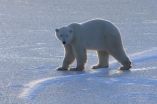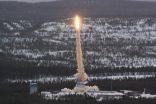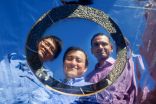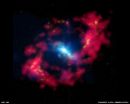Arctic conditions may become critical for polar bears by end of 21st century
Shifts in ice cover may impact arctic polar bear populations
2014-11-26
(Press-News.org) Shifts in the timing and duration of ice cover, especially the possible lengthening of ice-free periods, may impact polar bears under projected warming before the end of the 21st century, according to a study published November 26, 2014 in the open-access journal PLOS ONE by Stephen Hamilton from University of Alberta and colleagues.
Sea ice across the Arctic is declining and altering physical characteristics of marine ecosystems, and polar bears are vulnerable to these changes in sea ice conditions. The authors of this study used sea ice projections for the Canadian Arctic Archipelago from 2006-2100 and metrics developed from polar bear energetics modeling to gain insight into the conservation challenges for polar bears facing habitat loss.
Shifts away from multiyear ice to annual ice cover throughout the region, as well as lengthening ice-free periods, may become critical for polar bears before the end of the 21st century with projected warming. Each polar bear population in the Archipelago may undergo 2-5 months of ice-free conditions, where no such conditions exist presently. Under business-as-usual climate projections, polar bears may face starvation and reproductive failure across the entire Archipelago by the year 2100. "We predict that nearly one-tenth of the world's polar bear habitat, as much as one-quarter of their global population, may undergo significant habitat loss under business-as-usual climate projections," said Stephen Hamilton.
INFORMATION:
In your coverage please use this URL to provide access to the freely available paper: http://dx.plos.org/10.1371/journal.pone.0113746
Citation: Hamilton SG, Castro de la Guardia L, Derocher AE, Sahanatien V, Tremblay B, et al. (2014) Projected Polar Bear Sea Ice Habitat in the Canadian Arctic Archipelago. PLoS ONE 9(11): e113746. doi:10.1371/journal.pone.0113746
Funding: Funding was provided by WWF (Canada), ArcticNet, the Canadian Association of Zoos and Aquariums, Canadian Wildlife Federation, Environment Canada, Hauser Bears, Natural Sciences and Engineering Research Council of Canada, Office of Naval Research grant (N000141110977), Pittsburgh Zoo, Polar Continental Shelf Project, Polar Bears International, and Quark Expeditions. The funders had no role in study design, data collection and analysis, decision to publish, or preparation of the manuscript. Co-author David Huard is employed by David Huard Solutions. David Huard Solutions provided support in the form of salary for author David Huard, but did not have any additional role in the study design, data collection and analysis, decision to publish, or preparation of the manuscript. The specific roles of these authors are articulated in the 'author contributions' section.
Competing Interests: The authors have the following interests: Quark Expeditions is a commercial tour company that provided the authors with a donation research with no conditions. Co-author David Huard is employed by David Huard Solutions. There are no patents, products in development or marketed to declare. This does not alter the authors' adherence to all the PLOS ONE policies on sharing data and materials.
[Attachments] See images for this press release:

ELSE PRESS RELEASES FROM THIS DATE:
2014-11-26
Induced pluripotent stem cells made from patients with a form of blistering skin disease can be genetically corrected and used to grow back healthy skin cells in laboratory dishes, researchers at the Stanford University School of Medicine have found. They've termed the new technique "therapeutic reprogramming."
The skin cells formed normal human skin when grafted onto the backs of laboratory mice, they said.
The findings represent a major advance in the battle against the disease, epidermolysis bullosa, in which the top layer of skin, called the epidermis, sloughs off ...
2014-11-26
Some people say that reading "Harry Potter and the Sorcerer's Stone" taught them the importance of friends, or that easy decisions are seldom right. Carnegie Mellon University scientists used a chapter of that book to learn a different lesson: identifying what different regions of the brain are doing when people read.
Researchers from CMU's Machine Learning Department performed functional magnetic resonance imaging (fMRI) scans of eight people as they read a chapter of that Potter book. They then analyzed the scans, cubic millimeter by cubic millimeter, for every four-word ...
2014-11-26
Applied to the outer shell of the payload section of a rocket using pipettes, small, double-stranded DNA molecules flew into space from Earth and back again. After the launch, space flight, re-entry into Earth's atmosphere and landing, the so-called plasmid DNA molecules were still found on all the application points on the rocket from the TEXUS-49 mission. And this was not the only surprise: For the most part, the DNA salvaged was even still able to transfer genetic information to bacterial and connective tissue cells. "This study provides experimental evidence that the ...
2014-11-26
Scientists investigating the potentially deadly hantavirus have used a novel approach to developing protective antibodies against it. Their work, published in today's online edition of Science Translational Medicine, provides proof of concept for producing antibodies against a broad range of human pathogens.
Hantaviruses cause a condition known as hantavirus pulmonary syndrome (HPS), which has a case fatality rate of 35-40 percent. Currently there are no licensed vaccines, prophylactics, or therapeutics to prevent or treat this highly pathogenic disease.
This research ...
2014-11-26
This news release is available in German.
Scientists led by Kristina Djinović-Carugo at the Max F. Perutz Laboratories (MFPL) of the University of Vienna and the Medical University of Vienna have elucidated the molecular structure and regulation of the essential muscle protein α-actinin. The new findings allow unprecedented insights into the protein's mode of action and its role in muscle disorders. The findings, made in collaboration with King's College London (KCL), may lead to improved treatments, and are published in the top-class journal Cell.
Most ...
2014-11-26
A popular indigestion medication can increase survival in colorectal cancer, according to research published in ecancermedicalscience. But in fact, scientists have studied this for years - and a group of cancer advocates want to know why this research isn't more widely used.
"Cimetidine is an interesting drug as it's very safe, very well-known, and has clinical results in cancer that have been confirmed in a number of trials," says Pan Pantziarka, lead author of the paper and member of the Repurposing Drugs in Oncology (ReDO) project.
Cimetidine treats indigestion ...
2014-11-26
Stanford engineers have invented a revolutionary coating material that can help cool buildings, even on sunny days, by radiating heat away from the buildings and sending it directly into space.
A team led by electrical engineering Professor Shanhui Fan and research associate Aaswath Raman reported this energy-saving breakthrough in the journal Nature.
The heart of the invention is an ultrathin, multilayered material that deals with light, both invisible and visible, in a new way.
Invisible light in the form of infrared radiation is one of the ways that all objects ...
2014-11-26
A team of scientists, led by Dr Sebastian Hoenig from the University of Southampton, have developed a new way of measuring precise distances to galaxies tens of millions of light years away, using the W. M. Keck Observatory near the summit of Mauna Kea in Hawaii.
The method is similar to what land surveyors use on earth, by measuring the physical and angular, or 'apparent', size of a standard ruler in the galaxy, to calibrate the distance from this information.
The research, which is published in the journal Nature, was used to identify the accurate distance of the ...
2014-11-26
One of the major problems in astronomy is measuring very large distances in the universe. The current most common methods measure relative distances, but now research from the Niels Bohr Institute demonstrates that precise distances can be measured using supermassive black holes. The results are published in the scientific journal, Nature.
The active galaxy NGC 4151 called the, 'Eye of Sauron' due to its similarity to the eye in the film Lord of the Rings, is a modest spiral galaxy. It has a supermassive black hole at its centre and this black hole is still active, that ...
2014-11-26
BOSTON - A promising experimental immunotherapy drug works best in patients whose immune defenses initially rally to attack the cancer but then are stymied by a molecular brake that shuts down the response, according to a new study led by researchers at Dana-Farber Cancer Institute and the Yale University School of Medicine.
The antibody drug, known as MPDL3280A, inhibits the brake protein, PD-L1, reviving the response by immune killer T cells, which target and destroy the cancer cells. In recent clinical trials, the PD-L1 checkpoint blocker caused impressive shrinkage ...
LAST 30 PRESS RELEASES:
[Press-News.org] Arctic conditions may become critical for polar bears by end of 21st century
Shifts in ice cover may impact arctic polar bear populations






